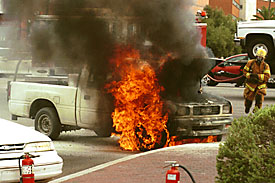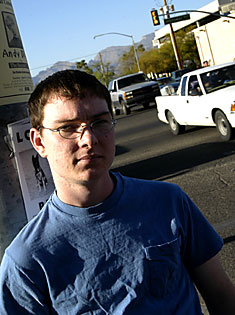 |
|
KEVIN KLAUS/Arizona Daily Wildcat
|
A pick-up truck traveling west on East Speedway Boulevard and North Park Avenue caught fire after being involved in a collision two years ago. This intersection on the north side of campus has been the scene of many traffic accidents.
|
|
By Devin Simmons
Arizona Daily Wildcat
Wednesday April 9, 2003
City looking into dangers of turning left at Park and Speedway intersection
Nate Riordan can no longer drive through the intersection of North Park Avenue and East Speedway Boulevard without a chill running down his spine and his hands tightening ever so slightly on the steering wheel.
"Every time I go to that intersection I freak out," said Riordan, an engineering and physical sciences junior.
Riordan, whose car was loaded with clothes he was taking back to his residence hall, was trying to make a left turn southbound onto Park Avenue. It was lunchtime, Jan. 12, when a car going well over 40 mph, ran the red light and slammed into Riordan's car. The impact was so intense that Riordan's car flipped on its side before slowly tipping over.
"When the car was on its side it was like time just stopped," Riordan said. "It was completely dark. It felt like night."
Riordan and his passenger, Victoria Harris, managed to climb out of the windows of the vehicle, as university police and several fire trucks responded to the scene.
It would take weeks for Riordan to get the gasoline smell out of his clothes.
Now he is convinced that a turn arrow is needed to prevent more accidents like his.
"We need a turn arrow there," Riordan said. "If there was an arrow, everyone would be more cautious about the left hand turn."
Riordan is not the only one who thinks the North Park Avenue and East Speedway Boulevard intersection is a danger zone. Many others have questioned its safety.
"If I was a betting man, I would say that a turn arrow might eliminate some issues there," said Commander Kevin Haywood, spokesperson for the University of Arizona Police Department. "It would allow some people to turn there more safely."
But a solution to its many problems has yet to be found.
 |
|
SAUL LOEB/Arizona Daily Wildcat
|
Riordan, an engineering and physical sciences junior, stands at the corner of North Park Avenue and East Speedway Boulevard yesterday afternoon. Riordan flipped his car, totaling it, in January 2003 at this intersection.
|
|
THE HEADACHES
It's the 5 p.m. rush hour. With cars backed up all along East Speedway Boulevard between Park and Mountain avenues, the street looks more like a parking lot than a major thoroughfare.
In a 2001 ranking of the busiest intersections in Pima County, a traffic volume of 68,900 cars per day placed the intersection of North Park Avenue and East Speedway Boulevard in the top 30.
What sets this intersection apart from others with similar traffic volume is that it doesn't have a left turn signal.
For instance, East Speedway Boulevard and North Stone Avenue, an intersection that sees about 3,000 fewer cars on a given day, has a left turn signal for cars to turn.
Many students driving this strip of road have come to expect the daily buildup of cars trying to make a left hand turn onto North Park Avenue in the same way that they expect the sun to rise in the east.
"That intersection is always so busy," said Melinda Peterson, a retail junior. "ItĪs really annoying when you get stuck out in the middle of the intersection and everybody else is mad at you."
Peterson waits to take the left turn at North Euclid Avenue. But others have chosen to turn north on North Park Avenue and try to make a u-turn to get going in the other direction.
 |
|
That intersection is so horrible, I avoid the left at all costs. Instead I turn right at Park and flip a (
-turn).- Zadok Huang
Finance and east-Asian studies junior
|
 |
"That intersection is so horrible," said Zadok Huang, a finance and east-Asian studies junior. "I avoid the left at all costs. Instead I turn right at Park and flip a (u-turn). It is my little trick."
Such "unsafe driving behavior" worries David Duffy, director of campus and facility planning. People turning north onto North Park Avenue that simply make a u-turn to get going southbound are doing so at a point where there really is no way to make a safe u-turn, Duffy said.
"We are constantly in discussions with the city over transportation-related issues," Duffy said. "The problem of turning westbound on to Park is definitely one of those issues."
The congestion is only part of the problem; compared to other nearby intersections, there are also more accidents.
Over the last two years, North Park Avenue has had twice as many accidents as its neighbor, North Mountain Avenue.
North Mountain Avenue has a left hand turn arrow and North Park Avenue does not.
THE OBSTACLES
When asked to explain the complexities of the intersection, Mark Hickman, an assistant professor in civil engineering, threw his pad on the table and began drawing graphs and maps.
One hour and six drawings later, it was clear that the solution wasn't simple.
The city has a tough situation on their hands, Hickman said.
"Overall, the city is doing the best they can with what they have to work with," he said.
Hickman, who has worked with the city on a number of other traffic projects, has studied North Park Avenue and East Speedway Boulevard in a class he teaches about signal timing and various other traffic-engineering principles.
One obstacle of putting a left turn signal in at the intersection has to do with timing, Hickman said. In order for everyone to hit a row of greens when driving down Speedway, the city developed a timing schedule where lights are coordinated in 90-second intervals to turn green in a way that keeps traffic moving.
The city calls this timing schedule, "signal coordination," Hickman said.
City planners have come to the conclusion that a 90-second cycle is the ideal amount of time for a car from one intersection to get to another without hitting a red light, said Bob Hunt, a civil engineer with the Tucson Department of Transportation.
This 90-second cycle is the same for every traffic signal in the city, no matter how busy the intersection is, Hickman said.
Adding a left turn signal, which lasts about 12 to 15 seconds, to the intersection would require city planners to modify the 90- second cycle, something they are unwilling to do, Hunt said.
Increasing the universal cycle time to accommodate North Park Avenue and East Speedway Boulevard would mean that they would have to decrease speed limits across the city, so traffic does not back up. The idea that drivers will be willing to slow down to 35 mph on most city streets isn't very realistic, he added.
Or in order to install that light at the intersection and stick to the 90-second limit, city planners would have to reduce the duration of the green light for either the drivers on North Park Avenue or the drivers on East Speedway Boulevard.
But reducing the length of the green light on North Park Avenue would make it impossible for pedestrians to cross Speedway's six lanes. And reducing the length of the green light on East Speedway Boulevard would increase traffic delays on an already burdened street.
"It's difficult, because someone is going to have to give up the time, either the pedestrians crossing Speedway or the cars traveling on Speedway," Hunt said.
The city has already decided that the benefit of accommodating left hand turns onto Park does not outweigh the price of increasing delays on Speedway, Hickman said.
If Hickman could make all of the decisions he said he would close off all of North Park Avenue from East Speedway Boulevard all the way to East Sixth Street.
This is an idea that has been tossed around for years, Duffy said.
"Overall, closing Park isn't a bad idea," he said. "But there are circulation issues that complicate things."
North Park Avenue has a number of drive-thru lanes for certain businesses, like banks and restaurants. Also, the movement of traffic around the perimeter of the campus is essential, Duffy said.
While the city is focused on issues such as timing, what the city needs to do is be more flexible about how to improve the Park and Speedway intersection, Duffy said.
Because the intersection is in a central location with significant traffic volume, the problem needs to be addressed, Duffy said.
"We encourage the city to look at the bigger picture," he said.
The city is planning to conduct a study in the coming weeks which will take a closer look at the feasibility of installing a turn arrow, Hunt said.
"I don't know how it is going to work, we'll just have to wait on the study." Hunt said.
In the meantime, Duffy has suggested a much easier solution to the problem.
If drivers want to avoid the problem of turning west onto North Park Avenue from East Speedway Boulevard, they should leave their cars at home, an act that would reduce the risk of an accident like Riordan's, Duffy said.
"The best solution to the problem, something that can be done now, is for people to get out of their cars, and onto the bus," Duffy said.

